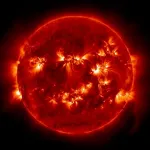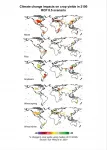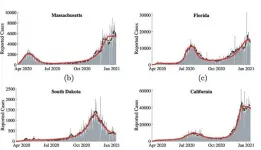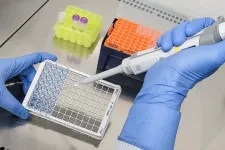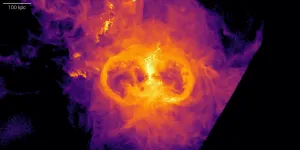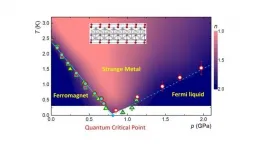(Press-News.org) Not only the very concise 11-year cycle, but also all other periodic solar activity fluctuations can be clocked by planetary attractive forces. This is the conclusion drawn by Dr. Frank Stefani and his colleagues from the Institute of Fluid Dynamics at the Helmholtz-Zentrum Dresden-Rossendorf (HZDR) and from the Institute of Continuous Media Mechanics in Perm, Russia. With new model calculations, they are proposing a comprehensive explanation of all important known sun cycles for the first time. They also reveal the longest fluctuations in activity over thousands of years as a chaotic process. Despite the planetary timing of short and medium cycles, long-term forecasts of solar activity thus become impossible, as the researchers in the scientific journal Solar Physics (DOI: 10.1007/s11207-021-01822-4) assert.
Solar physicists around the world have long been searching for satisfactory explanations for the sun's many cyclical, overlapping activity fluctuations. In addition to the most famous, approximately 11-year "Schwabe cycle", the sun also exhibits longer fluctuations, ranging from hundreds to thousands of years. It follows, for example, the "Gleissberg cycle" (about 85 years), the "Suess-de Vries cycle" (about 200 years) and the quasi-cycle of "Bond events" (about 1500 years), each named after their discoverers. It is undisputed that the solar magnetic field controls these activity fluctuations.
Explanations and models in expert circles partly diverge widely as to why the magnetic field changes at all. Is the sun controlled externally or does the reason for the many cycles lie in special peculiarities of the solar dynamo itself? HZDR researcher Frank Stefani and his colleagues have been searching for answers for years - mainly to the very controversial question as to whether the planets play a role in solar activity.
Rosette-shaped movement of the sun can produce a 193-year cycle
The researchers have most recently taken a closer look at the sun's orbital movement. The sun does not remain fixed at the center of the solar system: It performs a kind of dance in the common gravitational field with the massive planets Jupiter and Saturn - at a rate of 19.86 years. We know from the Earth that spinning around in its orbit triggers small motions in the Earth's liquid core. Something similar also occurs within the sun, but this has so far been neglected with regard to its magnetic field.
The researchers came up with the idea that part of the sun's angular orbital momentum could be transferred to its rotation and thus affect the internal dynamo process that produces the solar magnetic field. Such coupling would be sufficient to change the extremely sensitive magnetic storage capacity of the tachocline, a transition region between different types of energy transport in the sun's interior. "The coiled magnetic fields could then more easily snap to the sun's surface," says Stefani.
The researchers integrated one such rhythmic perturbation of the tachocline into their previous model calculations of a typical solar dynamo, and they were thus able to reproduce several cyclical phenomena that were known from observations. What was most remarkable was that, in addition to the 11.07-year Schwabe cycle they had already modeled in previous work, the strength of the magnetic field now also changed at a rate of 193 years - this could be the sun's Suess-de Vries cycle, which from observations has been reported to be 180 to 230 years. Mathematically, the 193 years arise as what is known as a beat period between the 19.86-year cycle and the twofold Schwabe cycle, also called the Hale cycle. The Suess-de Vries cycle would thus be the result of a combination of two external "clocks": the planets' tidal forces and the sun's own movement in the solar system's gravitational field.
Planets as a metronome
For the 11.07-year cycle, Stefani and his researchers had previously found strong statistical evidence that it must follow an external clock. They linked this "clock" to the tidal forces of the planets Venus, Earth and Jupiter. Their effect is greatest when the planets are aligned: a constellation that occurs every 11.07 years. As for the 193-year cycle, a sensitive physical effect was also decisive here in order to trigger a sufficient effect of the weak tidal forces of the planets on the solar dynamo.
After initial skepticism toward the planetary hypothesis, Stefani now assumes that these connections are not coincidental. "If the sun was playing a trick on us here, then it would be with incredible perfection. Or, in fact, we have a first inkling of a complete picture of the short and long solar activity cycles." In fact, the current results also retroactively reaffirm that the 11-year cycle must be a timed process. Otherwise, the occurrence of a beat period would be mathematically impossible.
Tipping into chaos: 1000-2000-year collapses are not more accurately predictable
In addition to the rather shorter activity cycles, the sun also exhibits long-term trends in the thousand-year range. These are characterized by prolonged drops in activity, known as "minima", such as the most recent "Maunder Minimum", which occurred between 1645 and 1715 during the "Little Ice Age". By statistically analyzing the observed minima, the researchers could show that these are not cyclical processes, but that their occurrence at intervals of approximately one to two thousand years follows a mathematical random process.
To verify this in a model, the researchers expanded their solar dynamo simulations to a longer period of 30,000 years. In fact, in addition to the shorter cycles, there were irregular, sudden drops in magnetic activity every 1000 to 2000 years. "We see in our simulations how a north-south asymmetry forms, which eventually becomes too strong and goes out of sync until everything collapses. The system tips into chaos and then takes a while to get back into sync again," says Stefani. But this result also means that very long-term solar activity forecasts - for example, to determine influence on climate developments - are almost impossible.
INFORMATION:
Publication:
F. Stefani, R. Stepanov, T. Weier, Shaken and stirred: When Bond meets Suess-de Vries and Gnevyshev-Ohl, in Solar Physics, 2021 (DOI: 10.1007/s11207-021-01822-4)
For more information:
Dr. Frank Stefani
Institute of Fluid Dynamics at HZDR
Phone: +49 351 260 3069 | Email: f.stefani@hzdr.de
Media contact:
Simon Schmitt | Head
Communications and Media Relations at HZDR
Phone: +49 351 260 3400 | Email: s.schmitt@hzdr.de
The Helmholtz-Zentrum Dresden-Rossendorf (HZDR) performs - as an independent German research center - research in the fields of energy, health, and matter. We focus on answering the following questions:
How can energy and resources be utilized in an efficient, safe, and sustainable way?
How can malignant tumors be more precisely visualized, characterized, and more effectively treated?
How do matter and materials behave under the influence of strong fields and in smallest dimensions?
To help answer these research questions, HZDR operates large-scale facilities, which are also used by visiting researchers: the Ion Beam Center, the High-Magnetic Field Laboratory Dresden, and the ELBE Center for High-Power Radiation Sources.
HZDR is a member of the Helmholtz Association and has six sites (Dresden, Freiberg, Grenoble, Görlitz, Leipzig, Schenefeld near Hamburg) with almost 1,200 members of staff, of whom about 500 are scientists, including 170 Ph.D. candidates.
On average the earliest memories that people can recall point back to when they were just two-and-a-half years old, a new study suggests.
The findings, published in peer-reviewed journal Memory, pushes back the previous conclusions of the average age of earliest memories by a whole year.
They are presented in a new 21-year study, which followed on from a review of already-existing data.
"When one's earliest memory occurs, it is a moving target rather than being a single static memory," explains childhood amnesia expert and lead author Dr Carole Peterson, from Memorial University of Newfoundland.
"Thus, what many people provide when asked for their earliest memory is not a boundary or watershed beginning, before which there are no memories. Rather, ...
Shifts in weather patterns induced by climate change will increase extreme heat and reduce rainfall across major crop growing regions, with impacts on agricultural production. Will this trigger a decline in the supply of calories needed to sustain the world's growing population?
According to a study published in the Journal of Environmental Economics and Management, global calorie supplies are subject to continuing or even increasing vulnerability to climate change. Climate change could reduce global crop yields by 10% by mid-century and 25% by century's end, under a vigorous warming scenario, if farmers cannot adapt better than they did historically. ...
Every day, around 15 000 children under the age of five die from causes that could have been prevented.
But the children of highly educated parents survive more often than others. This statistic applies worldwide, according to a newly published sweeping systematic review in The Lancet.
The mother's level of education is particularly important for her children's survival.
"One year of extra education for the mother is associated with an approximately three per cent reduction in mortality on average," says Professor Terje Andreas Eikemo at the Norwegian University of Science ...
PROVIDENCE, R.I. [Brown University] -- By adding behavioral components to an infectious disease model, Brown University researchers have developed a new modeling approach that captures the peaks and valleys in new COVID-19 cases seen over the past 16 months.
The approach, published in the journal Scientific Reports, could be useful in forecasting the future trends in the current pandemic, as well as in predicting the course of future ones.
"We know that people's behavior matters in terms of how an infection is spread," said Vikas Srivastava, an assistant professor of ...
Tsukuba, Japan - To study the immune system in human health and disease, scientists commonly use the genetic manipulation of mouse hematopoietic stem and progenitor cells (HSPCs) as a powerful model system. These studies have been extremely valuable in the fight against a number of human diseases. However, the current procedures are complex, time-consuming, and expensive.
In a new study published in NATURE COMMUNICATIONS, researchers at the University of Tsukuba have developed a novel technique that has the potential to overcome the limitations associated with these models, which are known as bone marrow (BM) chimeric mice. This system allows scientists to observe and investigate how ...
SARS-CoV-2 outbreaks involving care homes with fully vaccinated residents have been reported across Germany. In order to gain a better understanding of this phenomenon, a team of researchers from Charité - Universitätsmedizin Berlin used an outbreak at a Berlin-based facility to analyze virus-related data and study the immune responses of elderly residents following vaccination. The researchers' data, which have been published in Emerging Infectious Diseases*, confirm vaccine effectiveness in the elderly. However, they also indicate a delayed and slightly reduced immune response. In light of their findings, the researchers emphasize the need to vaccinate both caregivers and close contacts in order to better protect this high-risk group.
The BioNTech/Pfizer ...
Research combining systematic observations with cosmological simulations has found that, surprisingly, black holes can help certain galaxies form new stars. On scales of galaxies, the role of supermassive black holes for star formation had previously been seen as destructive - active black holes can strip galaxies of the gas that galaxies need to form new stars. The new results, published in the journal Nature, showcase situations where active black holes can, instead, "clear the way" for galaxies that orbit inside galaxy groups or clusters, keeping those galaxies from having their star formation disrupted as they fly through the surrounding intergalactic gas.
Active black holes are primarily thought to have a destructive influence on their surroundings. As they blast ...
At a classical second-order phase transition, condensed matter systems acquire long-range order upon cooling below the transition temperature, and the properties near the transition are driven by thermal fluctuations. These behaviors have been long explained by the Landau theory of phase transitions, which leads to the notion of universality, whereby systems with very different microscopic constituents exhibit certain universal macroscopic behaviors close to a phase transition. Some condensed matter systems however can be tuned so that the phase transition is suppressed to zero temperature at a quantum critical point (QCP), where the behaviors are no longer driven by thermal fluctuations, but by quantum fluctuations arising as a consequence of Heisenberg's uncertainty principle.
Heavy ...
North Carolina State University researchers continue to track the evolution of different strains of the plant pathogen that caused the Irish potato famine in the 1840s, which set down roots in the United States before attacking Europe.
NC State plant pathologists studied the genomes of about 140 pathogen samples - historic and modern - from 37 countries on six continents to track the evolution of differing strains of Phytophthora infestans, a major cause of late-blight disease on potato and tomato plants.
The study, published in Scientific Reports, shows that the historic lineage called FAM-1 was found in ...
Human papillomavirus (HPV) vaccines applied in national vaccination programs protect against most cancers associated with oncogenic, high-risk (hr) HPV types. Two recent studies demonstrate the impact of gender-neutral HPV vaccination in the overall protection against hrHPV infections already with low vaccination coverage.
More than 30 000 12-15-year-old Finnish girls and boys participated in a community-randomized trial that evaluated the impact of gender-neutral vs. girls-only HPV16/18 vaccination in the two school years of 2007-2008 and 2008-2009 in 33 communities. To evaluate the occurrence of HPV infections, pre- and post-vaccination serum samples collected in the same communities were used to measure the antibodies against ...
